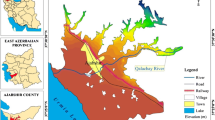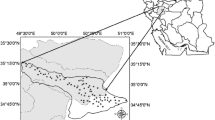Abstract
According to the characteristics of groundwater in arid area, this paper proposes DRAV model for groundwater vulnerability assessment, where D is groundwater depth, R is the net recharge of aquifer, A is the aquifer characteristics, and V is the lithology of vadose zone. As a case study, the paper assesses the vulnerability of pore phreatic water in Tarim Basin of Xinjiang, China by using the DRAV model. The results indicate that the areas of phreatic water with vulnerability index ranges of 2–4, 4–6, 6–8 and >8 accounting for 10.1, 80.4, 9.2 and 0.2% of the total plain area of the Tarim Basin respectively, and the areas with the latter two vulnerability ranges (6–8 and >8) are mainly located in the irrigation districts with thin soil layer (20–30 cm thick surface soil of vadose zone, mainly with underlying sandy gravel) and with silty and fine sand layer. Such vadose zone generally lacks sandy loam and clayey soil and has larger recharge by infiltration of irrigation water.





Similar content being viewed by others
References
Al-Adamat RAN, Foster IDL, Baban SMJ (2003) Groundwater vulnerability and risk mapping for t he Basaltic aquifer of the Azraq basin of Jordan using GIS, remote sensing and DRASTIC. Appl Geogr 23:303–324
Aller L, Bennet T, Lehr JH (1987) DRASTIC: a standardized system for evaluating groundwater pollution potential using hydrogeological setting, vol 37. US Environmental Protection Agency, Ada (Oklahoma), USA, pp 220–225
Bukowski P, Bromek T, Augustyniak I (2006) Using the DRASTIC system to assess the vulnerability of ground water to pollution in mined areas of the upper Silesian Coal Basin. Mine Water Environ 25:15–22
Burkart MR, Kolpin DW, James DE (1999) Assessing groundwater vulnerability to agrichemical contamination in the Midwest US. Water Sci Technol 39:103–112
Chen MX, Liu CQ, Chen CL, Wu BS, Zhang JH (2001) Drawing method guidelines for groundwater resources map. Geological Press, Beijing (in Chinese)
Dixon B (2005) Groundwater vulnerability mapping: a GIS and fuzzy rule based integrated tool. Appl Geogr 25:327–347
Dong XG, Deng MJ, Wang Z, Liu F, Zhao W, Zhou JL, Jiang HF (2005) Groundwater resources in Xinjiang. Xinjiang Science and Technology Publishing House, Urumchi, pp 18–21 (in Chinese)
Foster SSD (1987) Vulnerability of soil and groundwater to pollutions. Hydrol Proc Inf 20(17):116–121
Guo QH, Wang YX, Gao XB, Ma T (2007) A new model (DRARCH) for assessing groundwater vulnerability to arsenic contamination at basin scale: a case study in Taiyuan basin, northern China. Env Geol 52:923–932
Huang H, Dai ZJ, Hu ZN (2005) Coastal environment vulnerability study of Guangxi. Ocean Press, Beijing, p 77 (in Chinese)
Ibe KM, Nwankwor GI (2001) Assessment of groundwater vulnerability and its application to the development of protection strategy for the water supply aquifer in Owerri, southeastern Nigeria. Environ Monit Assess 67:323–360
Jiang GH (2002) The development of study on groundwater vulnerability. World Geol 21(1):33–38 (in Chinese)
Jiang FY, Guo QH (2008) Vulnerability of shallow groundwater of large-scale Cenozoic faulted basin: a case study at Taiyuan Basin, Shanxi Province, Northern China. Geol Sci Technol Inf 27(2):97–102 107(in Chinese)
Jiang ZQ, Zhu YS (2001) Evaluating regional groundwater pollution potential with DRASTIC for Daqinghe Basin. J Hehai Univ Nat Sci 29(2):100–103 (in Chinese)
Kourosh M, Ramin N,Vahid JM (2008) Aquifer vulnerability assessment using GIS and fuzzy system: a case study in Tehran–Karaj aquifer, Iran. Environ Geol. doi:10.1007/s00254-008-1514-7
Lake IR, Lovett AA, Hiscock KM, Betson M, Foley A, Sunnenberg G, Evers S, Fletcher S (2003) Evaluating factors influencing groundwater vulnerability to nitrate pollution: developing the potential of GIS. J Environ Manag 68:315–328
Lasserrea F, Razacka M, Bantonb O (1999) A GIS-linked model for the assessment of nit rate contamination in groundwater. J Hydrol 224:81–90
Lei J, Zhang SC (2003) Study on the groundwater vulnerability assessment in Tangshan plain area. Acta Sci Circumst 23(1):94–99 (in Chinese)
Ma JZ (2001) Groundwater vulnerability assessment for the south rim of Tarim Basin. J Desert Res 21(2):170–174 (in Chinese)
Ma ZM, Chen HH, Liu LC (2000) Controlling effect of quaternary hydrogeological structure on contaminating sensitivity of shallow groundwater, Taian City. Earth Sci J China Univ Geosci 25(5):472–476 (in Chinese)
Meinardi CR, Beusen AHW, Bollen MJS, Klepper O, Willems WJ (1995) Vulnerability to diffuse pollution and average nitrate contamination of European soils and groundwater. Water Sci Technol 31:159–165
Nobre RCM, Filho OCR, Mansur WJ, Nobre MMM, Cosenza CAN (2007) Groundwater vulnerability and risk mapping using GIS, modeling and a fuzzy logic tool. J Contam Hydrol 94:277–292
Panagopoulos GP, Antonakos AK, Lambrakis NJ (2006) Optimization of the DRASTIC method for groundwater vulnerability assessment via the use of simple statistical methods and GIS. Hydrogeol J 14:894–911
Sadek MA, El-Samie SGA (2001) Pollution vulnerability of the Quaternary aquifer near Cairo, Egypt, as indicated by isotopes and hydrochemistry. Hydrogeol J 9:273–281
Secunda S, Collin ML, Melloul AJ (1998) Groundwater vulnerability assessment using a composite model combining DRASTIC wit h extensive agricultural land use in Israel’s Sharon region. J Environ Manag 54:39–57
Soutter M, Musy A (1998) Coupling 1D Monte-Carlo simulations and geostatistics to assess groundwater vulnerability to pesticide contamination on a regional scale. J Contam Hydrol 32:25–39
Thapinta A, Hudak PF (2003) Use of geographic information systems for assessing groundwater pollution potential by pesticides in Central Thailand. Environ Int 29:87–93
Wang YX, Guo HM, Yan SL, Wang RF, Li YL (2004) Environmental evolution and pollution sensitivity of shallow pore groundwater system: a case study at Datong Basin. Science Press, Shanxi Province, pp 92–99 (in Chinese)
Worrall F, Besien T, Kolpin DW (2002) Groundwater vulnerability: interactions of chemical and site properties. Sci Total Environ 299:131–143
Yang Q, Luan MT (1999) An assessment method of groundwater vulnerability to pollution DRASTIC index system. Hydrogeol Eng Geol, 2:4–9 (in Chinese)
Zhong RS, Dong XG, Liu F, Zhou JL (2008) Evaluation of regional groundwater resources based 3S and VBA technology: a case study in Xinjiang. Geotech Investig Surv 5:38–41, 48 (in Chinese)
Zhou JL, Wang SX, Wang NY (2004) Application of fuzzy mathematics to assessing antipollution capability of unconfined aquifer. J Xinjiang Agric Univ 27(2):62–65 (in Chinese)
Acknowledgments
The study are financially supported by the National Science and Technology Support Planning Project of China (No.2007BAD38B01), the National Natural Science Foundation of China (No.40662002),the Grand Science and Technology Special Project of Xinjiang (No.20073117-3), the Scientific Research Planning Project of Xinjiang Higher Schools (No.XJEDU2007I13) and the Key Subject Foundation of Water Conservancy and Hydropower Project Foundation of Xinjiang (No.xjzdxk20080801
Author information
Authors and Affiliations
Corresponding author
Rights and permissions
About this article
Cite this article
Zhou, J., Li, G., Liu, F. et al. DRAV model and its application in assessing groundwater vulnerability in arid area: a case study of pore phreatic water in Tarim Basin, Xinjiang, Northwest China. Environ Earth Sci 60, 1055–1063 (2010). https://doi.org/10.1007/s12665-009-0250-y
Received:
Accepted:
Published:
Issue Date:
DOI: https://doi.org/10.1007/s12665-009-0250-y




